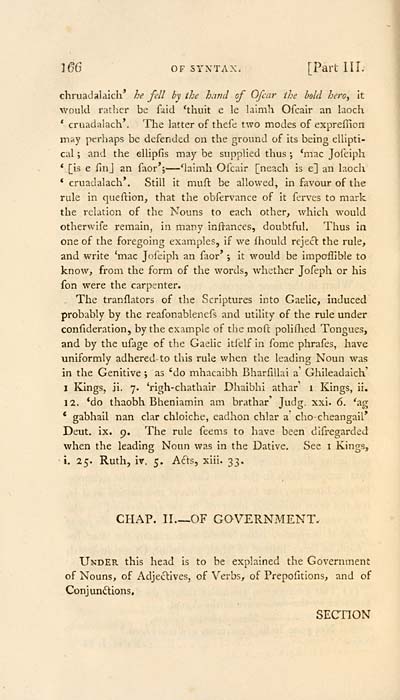Download files
Complete book:
Individual page:
Thumbnail gallery: Grid view | List view

ì66 OF SYNTAX. [Part III.
chruadalaich* he fell by the hand of Ofcar the hid hero^ It
would rather be faid 'thuit e le laimh Ofcair an laoch
* cruadalach*. The latter of thefe two modes of expreffion
may perhaps be defended on the ground of its being ellipti-
cal ; and the ellipfis may be supplied thus ; *mac Jofeiph
* [is e finj an faor*; — 'laimh Ofcair [neach is e] an laoch
* cruadalach*. Still it mufb be allowed, in favour of the
rule in queftion, that the obfervance of It ferves to mark
the relation of the Nouns to each other, which would
otherwife remain, in many inftances, doubtful. Thus in
one of the foregoing examples, if we fhould reject the rule,
and write *mac Jofeiph an faor' j it would be impolllble to
know, from the form of the words, whether Jofeph or his
fon were the carpenter.
The tranflators of the Scriptures into Gaelic, induced
probably by the reafonablenefs and utility of the rule under
confideration, by the example of the moft poliflied Tongues,
and by the ufage of the Gaelic Itfelf in Tome phrafes, have
uniformly adhered to this rule when the leading Noun was
in the Genitive ; as 'do mhacaibh Bharfillai a' Ghileadalch'
I Kings, ji. 7. *righ-chathair Dhaibhi athar' 1 Kings, ii,
12. *do thaobh Bheniamin am brathar' Judg. xxl. 6. 'ag
* gabhail nan clar chloiche, eadhon chlar a' cho-cheangall*
Deut. ix. 9. The rule feems to have been dlfregarded
when the leading Noun was in the Dative. See i Kings,
• i. 25. Ruth, iv. 5. A6ls, xiii. 33.
CHAP. II.— OF GOVERNMENT,
Under this head is to be explained the Government
of Nouns, of Adjeclives, of Verbs, of Prepofitions, and of
Conjundtions,
SECTION
chruadalaich* he fell by the hand of Ofcar the hid hero^ It
would rather be faid 'thuit e le laimh Ofcair an laoch
* cruadalach*. The latter of thefe two modes of expreffion
may perhaps be defended on the ground of its being ellipti-
cal ; and the ellipfis may be supplied thus ; *mac Jofeiph
* [is e finj an faor*; — 'laimh Ofcair [neach is e] an laoch
* cruadalach*. Still it mufb be allowed, in favour of the
rule in queftion, that the obfervance of It ferves to mark
the relation of the Nouns to each other, which would
otherwife remain, in many inftances, doubtful. Thus in
one of the foregoing examples, if we fhould reject the rule,
and write *mac Jofeiph an faor' j it would be impolllble to
know, from the form of the words, whether Jofeph or his
fon were the carpenter.
The tranflators of the Scriptures into Gaelic, induced
probably by the reafonablenefs and utility of the rule under
confideration, by the example of the moft poliflied Tongues,
and by the ufage of the Gaelic Itfelf in Tome phrafes, have
uniformly adhered to this rule when the leading Noun was
in the Genitive ; as 'do mhacaibh Bharfillai a' Ghileadalch'
I Kings, ji. 7. *righ-chathair Dhaibhi athar' 1 Kings, ii,
12. *do thaobh Bheniamin am brathar' Judg. xxl. 6. 'ag
* gabhail nan clar chloiche, eadhon chlar a' cho-cheangall*
Deut. ix. 9. The rule feems to have been dlfregarded
when the leading Noun was in the Dative. See i Kings,
• i. 25. Ruth, iv. 5. A6ls, xiii. 33.
CHAP. II.— OF GOVERNMENT,
Under this head is to be explained the Government
of Nouns, of Adjeclives, of Verbs, of Prepofitions, and of
Conjundtions,
SECTION
Set display mode to: Large image | Transcription
Images and transcriptions on this page, including medium image downloads, may be used under the Creative Commons Attribution 4.0 International Licence unless otherwise stated. ![]()
| Early Gaelic Book Collections > Blair Collection > Elements of Gaelic grammar > (198) |
|---|
| Permanent URL | https://digital.nls.uk/79042351 |
|---|
| Description | A selection of books from a collection of more than 500 titles, mostly on religious and literary topics. Also includes some material dealing with other Celtic languages and societies. Collection created towards the end of the 19th century by Lady Evelyn Stewart Murray. |
|---|
| Description | Selected items from five 'Special and Named Printed Collections'. Includes books in Gaelic and other Celtic languages, works about the Gaels, their languages, literature, culture and history. |
|---|

